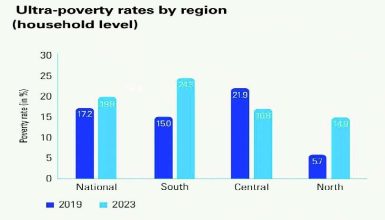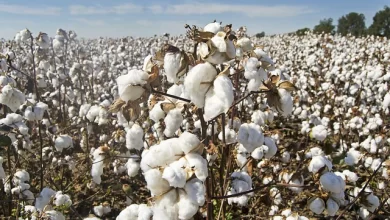Malawi faces K337bn maize production loss
A policy think tank assessment has forecast potentially damaging social-economic El Niño impact with Malawi expected to suffer around K337 billion maize yield loss, electricity load-shedding and water rationing.
That is not all! The Centre for Agricultural Research and Development (Card) has further predicted a fall in production of fish, one of the major sources of the country’s protein.
The potential overall consequences are that around 2.8 million people will suffer food insecurity, malnutrition will torture the citizenry and there will be increased deforestation amidst load-shedding.
The assessment follows a Department of Climate Change and Meteorological Services (MET) forecast which indicates that for the agricultural season starting October 2023 to April 2024, Malawi will experience normal to below normal rainfall with dry spells expected in most parts of the country.
Card, whose director is Innocent Pangapanga, said to come up with the finding it used the Auto Regressive Integrated Moving Average, a statistical analysis model that uses time series data to either better understand the data set or to predict future trends.
“We compile data from the FAOstats, World Bank Development Indicators and the Ministry of Agriculture for the years between 1961 and 2022.

Card, Lilongwe University of Agriculture and Natural Resources research centre, recalls that during the past El Niño conditions, power producers lost ability to produce electricity at full scale and it foresees a re-occurrence.
Malawi electricity generation largely depends on hydro, which accounts for above 95 percent of the total installed electric capacity, the brief dated October 24 2023, states.
“With the looming El Nino, the Shire River Basin may likely receive less rains throughout the period. In 2015-2016, El Nino reduced expected power generation capacity by 36 percent that is at Nkula Power Plant, rendering the nation to survive on power rationing.
On fish production, Card policy brief reads: “Reduced rainfall associated with higher temperatures will render drying up of ponds, rise in conditions where fish will lack oxygen, rise in ammonia production and increased multiplication of diseases and parasites.
“These situations will heavily influence survival and growth of fish, both juvenile and adult sizes, culminating into fish deaths and therefore substantially lowering fish biodiversity and yields.”
The low fish production will translate to reduced protein availability, Card warns, adding that “besides, low fish catch will likely affect the livelihood of fish farmers and fishers who depend on fish as their main source of income.”
The forecast further points out that water boards will also have to undertake water rationing as El Nino will result in low water supply in the reservoirs.
El Nino is a warming of Pacific waters which typically results in drier conditions, resulting in widespread crop failure, low production and drying up community watering points for people and livestock.
Meteorologists—local and international—have forecast that Malawi will bear the brunt of the harsh climatic conditions during the 2023/24 rainy season.
Card says that El Nino will reduce total production of maize, the country’s staple food, by 561 574 metric tonnes, which our calculations based on the current price of K660 per kilogramme, translates to around K337 billion.
The policy brief further reads: “[This] will translate into 466 528 metric tonnes under supplied for food demanded by households and 15 026 metric tonnes decline in maize which is supplied to the Strategic Grain Reserves in Malawi.
“Maize for industrial use will drop by 33 057 metric tonnes. Thus, we should expect at least 14 percent of the population [which is 2.8 million based on this paper’s projected current population of 20.8 million] becoming food insecure in 2024.”
To lessen the forecast impact, Card calls on water boards to invest in high yielding boreholes to supplement the water in the reservoirs.
To agriculture authorities, it recommends supply of climate-resilient crop varieties that are early maturing and drought-tolerant.
“Stakeholders should strengthen activities around alternative energy sources like access to gas and use of efficient technologies like cook stoves which demand less fuel to meet the daily needs of the households,” Card urges.
However, reacting to the forecast, head of department for earth sciences at Malawi University of Science and Technology Isaac Tchuwa said there was need to intensify agriculture extension messages to farmers on practising soil and water conservation techniques.
“About fish farming, the most critical thing is to encourage the treatment of micro-catchments where fish ponds are located so that as much surface water is captured, run off and soil erosion are minimised. This will help reduce the risk of fish ponds drying out,” he said.
On potential power generation challenges, Tchuwa said: “I’d be very careful here because the water flow regime in the Shire River is influenced by so many dynamics.
“For example, what is the current water level in Lake Malawi and how are we controlling this at the Liwonde Barrage? Remember, we are coming from a backdrop of very high inflows into the lake from the previous rainy season.
“These and many other complex factors that influence the behaviour of Shire River will need to be taken into account.”
He, however, expressed worry over the country’s capacity to withstand disasters.
“The most worrying thing is that this country already has very high underlying exposure and vulnerabilities to shocks and our capacities are severely undermined.
“What we are seeing and will continue to see is that any shocks that will come— regardless of their intensity and magnitude—will have devastating effects.
“Therefore, if the effects of El Nino are as bad as forecasted, then we are going to be in deep trouble. The food situation will be worsened and, as you know, a depleted food basket in this country usually brings with it all sorts of other dire socioeconomic consequences,” he concluded.
On its part, Lilongwe Water Board (LWB) said it has sufficient capacity to withstand El Nino without resorting to water rationing, but the Northern Region Water Board (NRWB) said it is currently developing contingency plans.
On his part, Minister of Agriculture Sam Kawale said government is already doing most of what has been proposed in view of the El Nino in the policy brief titled: The 2023/2024 El Nino: Uncertainties and Opportunities for the 2023-2024 agriculture season.
He said there is an intensified extension campaign and farmers are encouraged to plant early maturing and drought tolerant crops, among other interventions.
“All these are what we are already doing. They got that information from us,” said Kawale.





